Ram Accelerator
1. Description
2. Advantages
3. Disadvantages
4. Economics
5. Summary
1. Description
This looks like a giant gun and shoots a projectile out of its muzzle like a gun but works more like a ram jet engine. Through some mechanism (such as a light gas gun) the ram accelerator projectile is launched supersonically into the ram accelerator barrel.
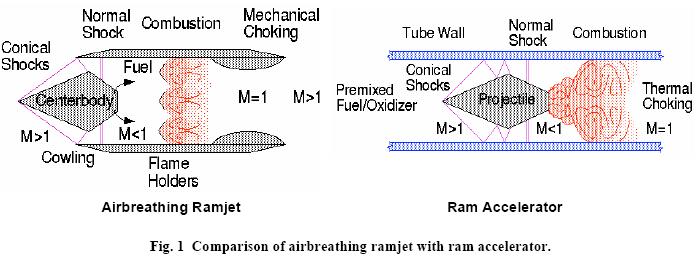
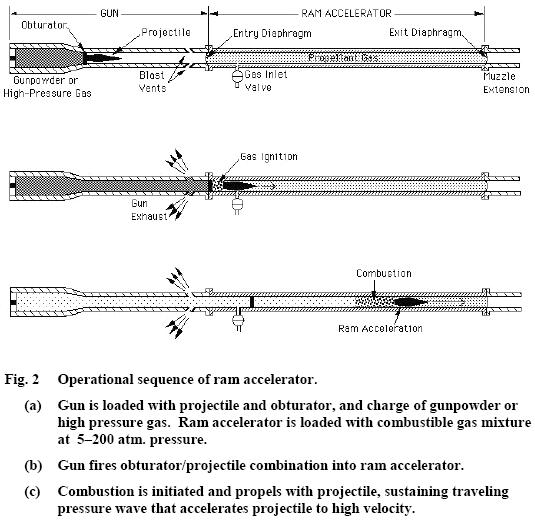
An animation showing how a ram accelerator works:
The bottom schematic shows the acceleration profile of both a light gas gun and a ram accelerator. Note that the ram accelerator experiences a peak acceleration around a specific velocity which is different for different gas types. The ram accelerator acceleration profile is the lower one of the two schematics.
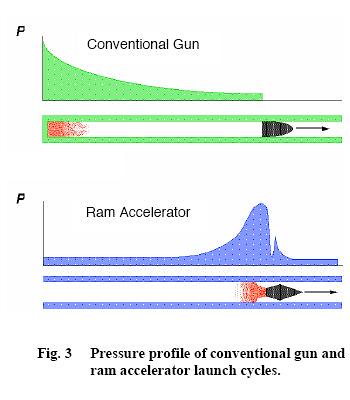
The interesting thing about the ram accelerator is that the launch tube can be subdivided into different segments with different gas mixtures in each segment. This permits the ram accelerator to performance to be tailored to both keep the peak acceleration tremendously lower than that for a gun while simultaneously maximizing the total acceleration of the system.
To put it simply, you can create a manned launch system (unlike the light gas gun) and achieve a higher muzzle velocity than the light gas gun too.
Back to the top
2. Advantages
Reusable launch infrastructure
The ram accelerator, like the light gas gun I advocated early, can reuse all of its infrastructure except the projectile itself. In fact the majority of the cost for the ram accelerator will be sunk into the construction of its combustion chamber and launch tube. The chamber may see some erosion due to the very high temperature and pressure gases burned by the super sonic combustion occurring in the accelerator. However, (like the light gas gun) since the chamber won't be carried with the vehicle, the designers can vastly over design the chamber, include plenty of margin for any chamber erosion, and use heavy, cheap, and strong construction materials.
This system will also require a vast infrastructure for generating hydrogen and oxygen for use in the launch tube. This infrastructure will also remain on ground but the costs for the electrolysis (for separating the gases) and a tank farm for storing the compressed gases would need to be built.
Doesn’t have to carry its propellant
A ram accelerator will carry only a tiny amount of its own propellant. In fact it will require only a small amount of fuel to circularize the projectile's orbit after getting into space.
Unlike the light gas gun, the ram accelerator has a few distinct advantages. First the projectile already possesses a divergent nozzle. This nozzle can be reused in the form of a aerospike type engine nozzle during the circularization burn. This means no other rocket motor needs to be carried, the vehicle just needs to carry extra fuel for this purpose.

Another advantage is less certain but more exciting. Inside the launch tube, the ram accelerator depends upon the walls of the launch tube to reflect the combustion gases back upon the rear of the projectile to produce thrust. Once the projectile/vehicle leaves the launch tube it will be moving at mach 22 or more. The shockwave generated by the vehicle will be strong enough to reflect any combustion gases back upon the rear of the vehicle to produce thrust. This is called external scramjet combustion. It can be used to adjust the trajectory of the ram accelerator projectile while in flight and reduce the amount of pure rocket propulsion the craft needs later.
Safe for nearby vehicles
A couple of the launch concepts (those using lasers and nuclear weapons) are unsafe for anything nearby. The ram accelerator suffers from none of those problems.
Can use cheap materials
Since the majority of the equipment required for this concept remains on the ground, very cheap construction materials (concrete and steel) can be used to build it. No advanced composites, no aircraft aluminum alloys, etc. The launch vehicle itself probably will require the use of materials able to handle high temperatures (titanium, nickel-iron, or ceramics) but the underlying structure will probably be constructed of composites and/or aluminum.
Space launch
Some propulsion systems I expect to write about (e.g. the NERVA concept) really don't have the ability to launch anything into space (the thrust to weight ratio is wrong). However, a ram accelerator is capable of launching cargo into space from Earth (you could also use it from other locations like the moon but it wouldn't make much sense to use it there). It could not be used for interplanetary propulsion and better systems exist for launching cargo from the moon or satellites.
The ram accelerator can launch the vehicles to more than 8 km/s. Perhaps another 1-2 km/s may be required to get into orbit (to overcome the friction of the vehicle moving through the air).
Cheap
This could be one of the premiere methods of launching indelicate cargo into space (e.g. bulk launching of water). At an estimated launch cost of $500 per pound, bulk materials like water, fuel, gases, and food would be MUCH cheaper to get into space in this manner.
Gentle acceleration
Unlike the light gas gun, the ram accelerator can tailor the acceleration of the projectile. Interestingly the ability to tune the performance of the ram accelerator means that the projectile can take a range of different masses and still launch them at the proper velocity. Stated another way, the ram accelerator can be used to launch people into orbit.
The ram accelerator would have to trade the amount of acceleration against the length of the launch tube. To launch at 3 g's would take a launch tube of 362 km about 225 miles! If you upped that to 5 g's (about the most someone who hasn't trained can withstand for the duration of the launch) it would cut that distance down to around 160 km (about 81 miles). Both of these make for very large construction projects. Meanwhile the light gas gun might only need a few kilometer long tunnel due to its high acceleration.
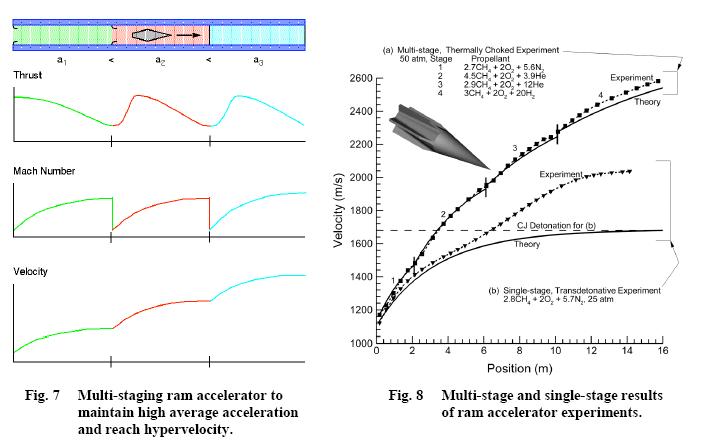
Back to the top
3. Disadvantages
This concept still suffers from a few difficulties; however, most of these have relatively simple and straight forwards solutions.
Requires some technological breakthroughs
Although there are operational ram accelerators now, some computational fluid dynamic studies must still be performed to optimize a ram accelerator for use as a component of space infrastructure. Additionally the high temperatures and pressures encountered while burning the launch tube gases in the accelerator and then encountered while traveling through the atmosphere would require a more sophisticated projectile than that of the light gas gun.
I believe this work would be relatively easy to complete but work still needs to be performed.
Substantial turn-around time
Unlike the lightcraft concept, each launch will require a significant amount of set up. This includes the separation of water into oxygen and hydrogen, setting up the different launch tube segments, and filling each segment with the proper mixture of gasses to get the acceleration required for the mission profile.
Light payloads
One desperate need for space launch is the ability to launch large and heavy structures (e.g. large hunks of required space infrastructure). Although it would be possible to build a super-size ram accelerator to launch huge payloads into space, I find it unlikely we'll do so in the near future - especially since we haven't even bothered to build a small one for space launch.
Back to the top
4. Economics
The graphic below states that a launch cost of $500 / lb are achievable with a ram accelerator.
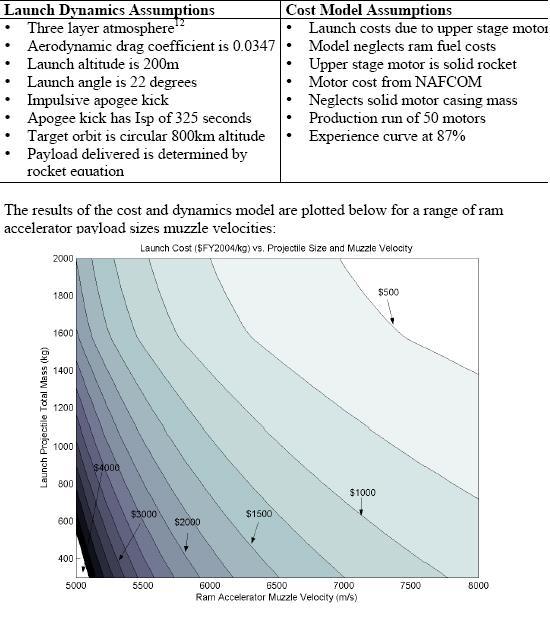
However, many of the assumptions used in this image are not that good.
Launch Dynamics
An ideal accelerator would launch the projectile at a higher altitude which because of the lower atmospheric density will lower drag.
The stated apogee kick motor uses a very poor performance rocket (a solid rocket motor performance like the Payload Assist Module). A more realistic assumption could use an Isp of 400 or more when used in a vacuum such as when circularizing an orbit.
An 800 km orbit is a very high for a low Earth orbit.
Cost model assumptions
As for costs, ignoring the cost of gases loaded into the accelerator tube for the launch is a very bad assumption. This will probably be the second largest cost of each launch (second only to the construction of the projectile itself). Some research into the costs for generating compressed gases would probably yield an accurate value for this cost (but I haven't done that research - sorry).
The motor casing weight fraction would be about 10% or so of the weight of the apogee kick motor like the PAM. However, if the rear of the projectile is adaptable for this purpose, it would save nearly all of this weight penalty.
Finally, a production run of 50 motors would be a very pessimistic assumption. The system would be capable of launching up to one payload a day although 1 per week or month would be more likely for the initial launch frequency.
Considering that the cost assumptions for the light gas gun examined in my previous blog listed a launch mass of 7200 lbs (a much larger mass than shown in this chart), a $300 / lb launch cost might be possible for such a large launch mass in a ram accelerator.
Overall I give the following qualitative assessment:
The ram accelerator projectile will cost more than the light gas gun projectile.
The ram accelerator's working fluids (mostly hydrogen) will cost more than the light gas gun's working fluids.
This will drive the ram accelerator's launch costs to be greater than those for the light gas gun.
However, the ram accelerator acceleration will be more gentle and the top velocity of the system is higher. This means that the ram accelerator will be able to both launch fragile cargo (like humans) and it will possess more capabilities to tailor the launch profile for a given cargo (different inclination, different orbital parameters).
Back to the top
5. Summary
1. Description
2. Advantages
3. Disadvantages
4. Economics
5. Summary
1. Description
This looks like a giant gun and shoots a projectile out of its muzzle like a gun but works more like a ram jet engine. Through some mechanism (such as a light gas gun) the ram accelerator projectile is launched supersonically into the ram accelerator barrel.


An animation showing how a ram accelerator works:
The bottom schematic shows the acceleration profile of both a light gas gun and a ram accelerator. Note that the ram accelerator experiences a peak acceleration around a specific velocity which is different for different gas types. The ram accelerator acceleration profile is the lower one of the two schematics.

The interesting thing about the ram accelerator is that the launch tube can be subdivided into different segments with different gas mixtures in each segment. This permits the ram accelerator to performance to be tailored to both keep the peak acceleration tremendously lower than that for a gun while simultaneously maximizing the total acceleration of the system.
To put it simply, you can create a manned launch system (unlike the light gas gun) and achieve a higher muzzle velocity than the light gas gun too.
Back to the top
2. Advantages
Reusable launch infrastructure
The ram accelerator, like the light gas gun I advocated early, can reuse all of its infrastructure except the projectile itself. In fact the majority of the cost for the ram accelerator will be sunk into the construction of its combustion chamber and launch tube. The chamber may see some erosion due to the very high temperature and pressure gases burned by the super sonic combustion occurring in the accelerator. However, (like the light gas gun) since the chamber won't be carried with the vehicle, the designers can vastly over design the chamber, include plenty of margin for any chamber erosion, and use heavy, cheap, and strong construction materials.
This system will also require a vast infrastructure for generating hydrogen and oxygen for use in the launch tube. This infrastructure will also remain on ground but the costs for the electrolysis (for separating the gases) and a tank farm for storing the compressed gases would need to be built.
Doesn’t have to carry its propellant
A ram accelerator will carry only a tiny amount of its own propellant. In fact it will require only a small amount of fuel to circularize the projectile's orbit after getting into space.
Unlike the light gas gun, the ram accelerator has a few distinct advantages. First the projectile already possesses a divergent nozzle. This nozzle can be reused in the form of a aerospike type engine nozzle during the circularization burn. This means no other rocket motor needs to be carried, the vehicle just needs to carry extra fuel for this purpose.

Another advantage is less certain but more exciting. Inside the launch tube, the ram accelerator depends upon the walls of the launch tube to reflect the combustion gases back upon the rear of the projectile to produce thrust. Once the projectile/vehicle leaves the launch tube it will be moving at mach 22 or more. The shockwave generated by the vehicle will be strong enough to reflect any combustion gases back upon the rear of the vehicle to produce thrust. This is called external scramjet combustion. It can be used to adjust the trajectory of the ram accelerator projectile while in flight and reduce the amount of pure rocket propulsion the craft needs later.
Safe for nearby vehicles
A couple of the launch concepts (those using lasers and nuclear weapons) are unsafe for anything nearby. The ram accelerator suffers from none of those problems.
Can use cheap materials
Since the majority of the equipment required for this concept remains on the ground, very cheap construction materials (concrete and steel) can be used to build it. No advanced composites, no aircraft aluminum alloys, etc. The launch vehicle itself probably will require the use of materials able to handle high temperatures (titanium, nickel-iron, or ceramics) but the underlying structure will probably be constructed of composites and/or aluminum.
Space launch
Some propulsion systems I expect to write about (e.g. the NERVA concept) really don't have the ability to launch anything into space (the thrust to weight ratio is wrong). However, a ram accelerator is capable of launching cargo into space from Earth (you could also use it from other locations like the moon but it wouldn't make much sense to use it there). It could not be used for interplanetary propulsion and better systems exist for launching cargo from the moon or satellites.
The ram accelerator can launch the vehicles to more than 8 km/s. Perhaps another 1-2 km/s may be required to get into orbit (to overcome the friction of the vehicle moving through the air).
Cheap
This could be one of the premiere methods of launching indelicate cargo into space (e.g. bulk launching of water). At an estimated launch cost of $500 per pound, bulk materials like water, fuel, gases, and food would be MUCH cheaper to get into space in this manner.
Gentle acceleration
Unlike the light gas gun, the ram accelerator can tailor the acceleration of the projectile. Interestingly the ability to tune the performance of the ram accelerator means that the projectile can take a range of different masses and still launch them at the proper velocity. Stated another way, the ram accelerator can be used to launch people into orbit.
The ram accelerator would have to trade the amount of acceleration against the length of the launch tube. To launch at 3 g's would take a launch tube of 362 km about 225 miles! If you upped that to 5 g's (about the most someone who hasn't trained can withstand for the duration of the launch) it would cut that distance down to around 160 km (about 81 miles). Both of these make for very large construction projects. Meanwhile the light gas gun might only need a few kilometer long tunnel due to its high acceleration.

Back to the top
3. Disadvantages
This concept still suffers from a few difficulties; however, most of these have relatively simple and straight forwards solutions.
Requires some technological breakthroughs
Although there are operational ram accelerators now, some computational fluid dynamic studies must still be performed to optimize a ram accelerator for use as a component of space infrastructure. Additionally the high temperatures and pressures encountered while burning the launch tube gases in the accelerator and then encountered while traveling through the atmosphere would require a more sophisticated projectile than that of the light gas gun.
I believe this work would be relatively easy to complete but work still needs to be performed.
Substantial turn-around time
Unlike the lightcraft concept, each launch will require a significant amount of set up. This includes the separation of water into oxygen and hydrogen, setting up the different launch tube segments, and filling each segment with the proper mixture of gasses to get the acceleration required for the mission profile.
Light payloads
One desperate need for space launch is the ability to launch large and heavy structures (e.g. large hunks of required space infrastructure). Although it would be possible to build a super-size ram accelerator to launch huge payloads into space, I find it unlikely we'll do so in the near future - especially since we haven't even bothered to build a small one for space launch.
Back to the top
4. Economics
The graphic below states that a launch cost of $500 / lb are achievable with a ram accelerator.

However, many of the assumptions used in this image are not that good.
Launch Dynamics
An ideal accelerator would launch the projectile at a higher altitude which because of the lower atmospheric density will lower drag.
The stated apogee kick motor uses a very poor performance rocket (a solid rocket motor performance like the Payload Assist Module). A more realistic assumption could use an Isp of 400 or more when used in a vacuum such as when circularizing an orbit.
An 800 km orbit is a very high for a low Earth orbit.
Cost model assumptions
As for costs, ignoring the cost of gases loaded into the accelerator tube for the launch is a very bad assumption. This will probably be the second largest cost of each launch (second only to the construction of the projectile itself). Some research into the costs for generating compressed gases would probably yield an accurate value for this cost (but I haven't done that research - sorry).
The motor casing weight fraction would be about 10% or so of the weight of the apogee kick motor like the PAM. However, if the rear of the projectile is adaptable for this purpose, it would save nearly all of this weight penalty.
Finally, a production run of 50 motors would be a very pessimistic assumption. The system would be capable of launching up to one payload a day although 1 per week or month would be more likely for the initial launch frequency.
Considering that the cost assumptions for the light gas gun examined in my previous blog listed a launch mass of 7200 lbs (a much larger mass than shown in this chart), a $300 / lb launch cost might be possible for such a large launch mass in a ram accelerator.
Overall I give the following qualitative assessment:
The ram accelerator projectile will cost more than the light gas gun projectile.
The ram accelerator's working fluids (mostly hydrogen) will cost more than the light gas gun's working fluids.
This will drive the ram accelerator's launch costs to be greater than those for the light gas gun.
However, the ram accelerator acceleration will be more gentle and the top velocity of the system is higher. This means that the ram accelerator will be able to both launch fragile cargo (like humans) and it will possess more capabilities to tailor the launch profile for a given cargo (different inclination, different orbital parameters).
Back to the top
5. Summary
|
Positive attributes of
craft
|
LC
|
LGG
|
RA
|
NPP
|
NR
|
FFR
|
CR
|
|
Most equipment reused?
|
Yes
|
Yes
|
Yes
|
Yes
|
Yes
|
Yes
|
No
|
|
Doesn't carry its
propellant?
|
Yes
|
Yes
|
Yes
|
Yes1
|
No
|
Yes1
|
No
|
|
Rapid turn around?
|
Yes
|
No
|
No
|
Yes
|
No
|
Yes4
|
No
|
|
Safe for nearby craft?
|
No
|
Yes
|
Yes
|
No
|
Yes
|
Yes
|
Yes
|
|
Can use cheap
materials?
|
Yes
|
Yes
|
Yes
|
Yes
|
No
|
No
|
No
|
|
Requires no
breakthroughs?
|
Yes
|
Yes
|
No
|
Yes
|
Yes
|
No
|
Yes
|
|
Gentle acceration3
|
Yes
|
No
|
Yes
|
Yes
|
Yes
|
Yes
|
Yes
|
|
Large payloads (>50
tons)
|
No
|
No
|
No
|
Yes
|
Yes
|
Yes
|
Yes
|
|
Interplanetary flight
|
No
|
No
|
No
|
Yes
|
Yes
|
Yes
|
Yes
|
|
Space launch
|
Yes
|
Yes
|
Yes
|
Yes
|
No
|
No
|
Yes
|
|
Estimated launch cost
per pound
|
<$500
|
<$500
|
$500
|
<$5002
|
N/A
|
N/A
|
>$10,000
|
|
Score
|
7
|
6
|
6
|
9
|
6
|
7
|
6
|
- LC – Lightcraft
- LGG – Light Gas Gun
- RA – Ram Accelerator
- NPP – Nuclear Pulse Propulsion
- NR – Nuclear Rocket
- STS – Space Transportation System aka Space Shuttle
- Nuclear pulse propulsion has such good performance that this really isn't a drawback for that concept.
- I'm making a WAG (wild @$$ed guess) at this because I have no idea how much nuclear bombs cost.
- This is a measure of whether the system could be used for manned vehicles. Many of these systems can be tuned to provide different accelerations.
Back to the top
Proceed to my next space blog, The Case for Space VIII: Nuclear Pulse Propulsion.
Return to my previous space blog, The Case for Space VI: Light gas gun.
No comments:
Post a Comment